Bucking the Boot Trend
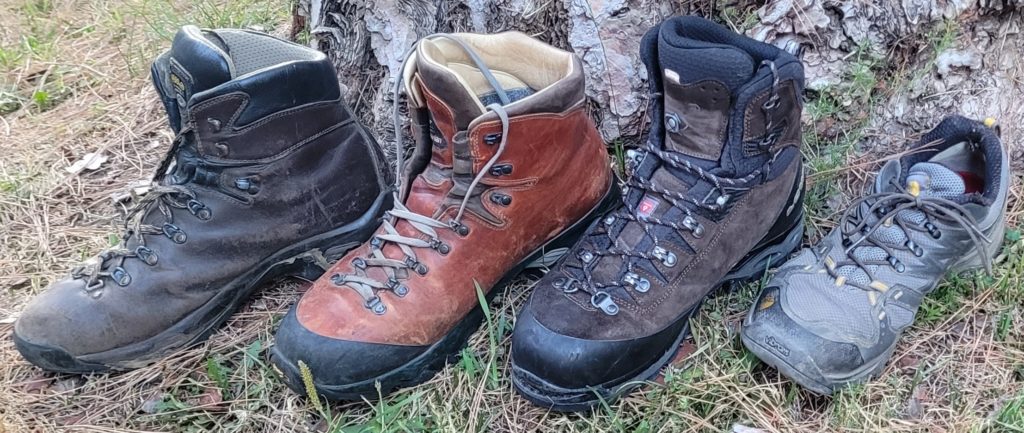
As a large, self-proclaimed Adonis of a man who hikes in disparate conditions I ask a lot from a pair of hiking boots and have destroyed inferior quality footwear in a matter of months. I need superior traction, exceptional durability, stability, and weather resistance while being comfortable.
How I define “hiking”:
My typical hikes run 5-17 miles, usually in mountainous terrain consisting of random parts dirt trail, scree/talus, snow, mud, sand, and those annoying roots and rocks which suddenly appear to trip and kill you. I’ll be doing this with a small pack to an 80L pack, running featherweight to 30#, in all weather conditions with a special enjoyment of snow hiking which may mean snowshoes, microspikes or even crampons. Elevation changes on the bigger hikes run 4K-6K. Some good examples are Half Dome, Mt. Baldy, San Jacinto. Obviously those are the biggies but I’ll often do those types of trails on a much shorter hike. For something shorter or more brisk a lighter hiking shoe or trail runner is fine. For example, I ran low-top hikers on Strawberry Peak and if it weren’t for the fact that the toe-box was too cramped for the trail type they’d have been mostly fine.
I typically look for the following: Gore-Tex, full Leather with minimal stitching, Vibram, heel brake, squarish heel, rubber toe rand, ~3/4 shank or similar.
Gore-Tex:
I almost always look for Gore-Tex although the thickness and completeness of the leather on the boot can make this negotiable, but it usually doesn’t have to be such. Many people note that Gore-Tex makes their feet run hot but I must have different appendages because while I much prefer cold to heat and sweat more than most, I’ve never really had an issue with it. As you can see in the pictures, I run large, relatively heavy, unventilated boots and have hiked in all weather from below zero and above 100 with few issues. I will say that very hot, very dry, very dusty, very long, very exposed days will have my feet feeling hot, but then again my body will be crying out for water and I’ll be hurting from the hair down as it is so warm feet aren’t the primary consideration. There are other brands out there which probably work fine, some proprietary to the manufacturer and for a high end boot I’m willing to consider that. Cheaper boots tend to just have what feels like a plastic sock inside which will make your feet sweat.
Full leather with minimal stitching:
—Ignoring conversations about full grain, split, Nubuck, suede, etc. because pretty much every high quality boot will have a good leather—
There is a trend toward lightweight, synthetic materials with welded seams and there is absolutely a place for those types of shoes. My running shoes are of that type of construction and they’re great. They ventilate well and are very light weight – something which is a factor on longer hikes. However, what the thinner, softer, more flexible boots lack is structure and often support. I don’t like the fabric getting caught on a protrusion or having something strike my toes or feet. Or maybe I just prefer leather. That said, the more stitching on the boot the more chances for failure. Seams rip, double layers don’t flex as well and crack and frankly, the seams are there mostly for style, not function. I prefer utility first and let the style follow.
There is a caveat to consider on this and it’s worth mentioning: Leather, especially thick leather doesn’t dry very quickly and Gore-Tex both can wear out or separate from the boot and regardless still doesn’t dry as fast as a well ventilated boot. I read an article somewhere where the lady was talking about why she stopped wearing waterproof boots on through hikes. The gist of it was that her feet were going to get wet regardless so she’d rather dry off the wet boots quickly (and change socks) than walk around in heavy, soggy (and “hot”) boots and risk getting swamp foot. She made a good point and while I completely go the opposite direction it’s a worthwhile consideration. Where that fails for me is when your hike involves slush or multiple water crossings. Even a small creek with nicely spaced rocks can get your foot wet if (when) your toe slips. Wet feet transitions from annoying to extremely dangerous in the winter though.
But why worry about the full leather when I already have Gore-Tex? Legit question and frankly, it’s a flexible point depending on the shoe design. For example, the La Sportiva Trango famously doesn’t have a lick of leather and are in fact, made of the aforementioned welded and synthetic design. Indeed they’re apparently fantastic boots (I’ve even considered them).
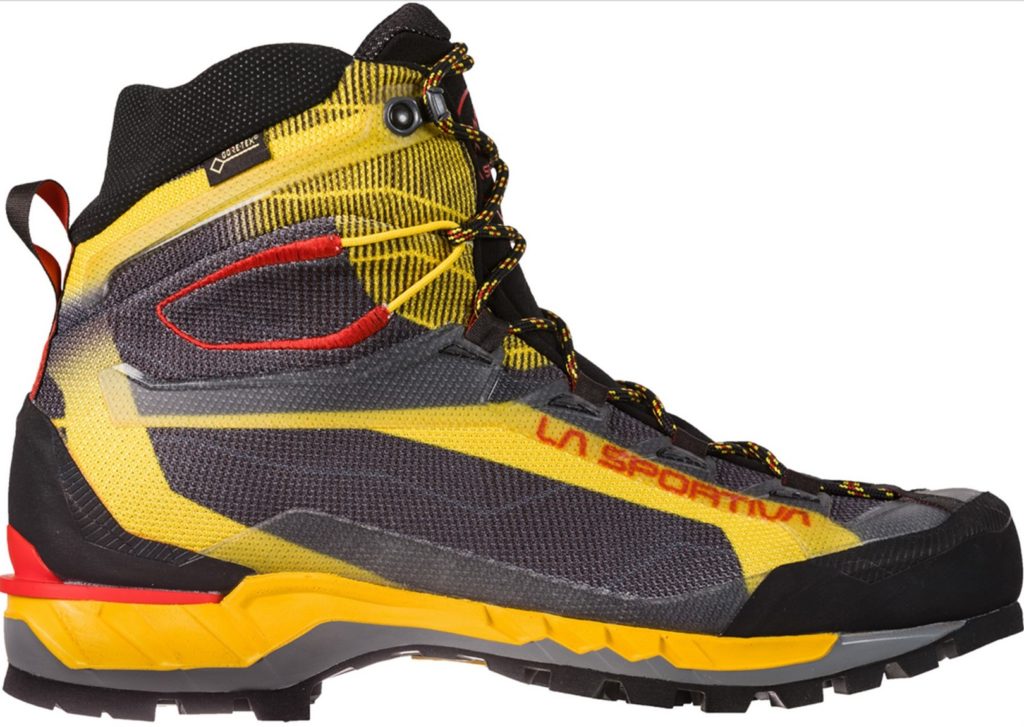
First, I’d prefer to have the Gore-Tex be the backup to the known quality of the leather rather than the technology to be relied upon. I will note that the Trango specifically notes the uppers are made of “QB3 Waterproof Fabric / Thermo-Tech Injection Coating” but I’m always wary of the longevity of coatings. I just had to redo the seam seal on my tent the other week… Well cared-for leather is considerably water resistant and will last a very, very long time. It’s also extremely durable. There’s a reason leather is still the default for smoke jumper boots. But that said, there’s a time and place for everything and the more specialized the requirement the more specialized the materials.
Vibram:
Over the years I’ve found that Vibram soles (pronounced Veebruhm) are the best of the best and have never let me down so that’s generally one of my deal-breaker baselines. They basically invented the modern boot sole. Also tends to be that boots with Vibram soles are usually resolable. It’s less of a concern on sub $150 boots which I tend to consider more of a shorter term consumable than an investment. Vibram will last you years of abuse and will retain traction from the car to the summit and back, can’t really ask much more than that.
Heel Brake:
This is the gap between the heel and the front sole. Look at any western boot, logger boot or men’s dress shoes and you’ll see that gap. While many shoes don’t have this, instead having a sole contacting the ground essentially from the toe to the heel, I find it an absolute necessity. Literally speaking, it acts as a brake as I’m walking downhill or over rocks. It’s a stopping point for the shoe when I’m stepping on rocks as well as a recessed mounting point for gator straps. Technically the full-contact sole may have more traction but I find it makes the shoes act like skis in loose terrain. Having that heel just dig in and stop the boot has saved me from falling innumerable times. Again, less of an issue on something lightweight and inexpensive but I won’t even look at any other design for rugged terrain. Side note: I’m not even offering any consideration to the rear-extended heels on shoes like the Hoka GTX. May or may not be a decent shoe, I’d fall and die in those.
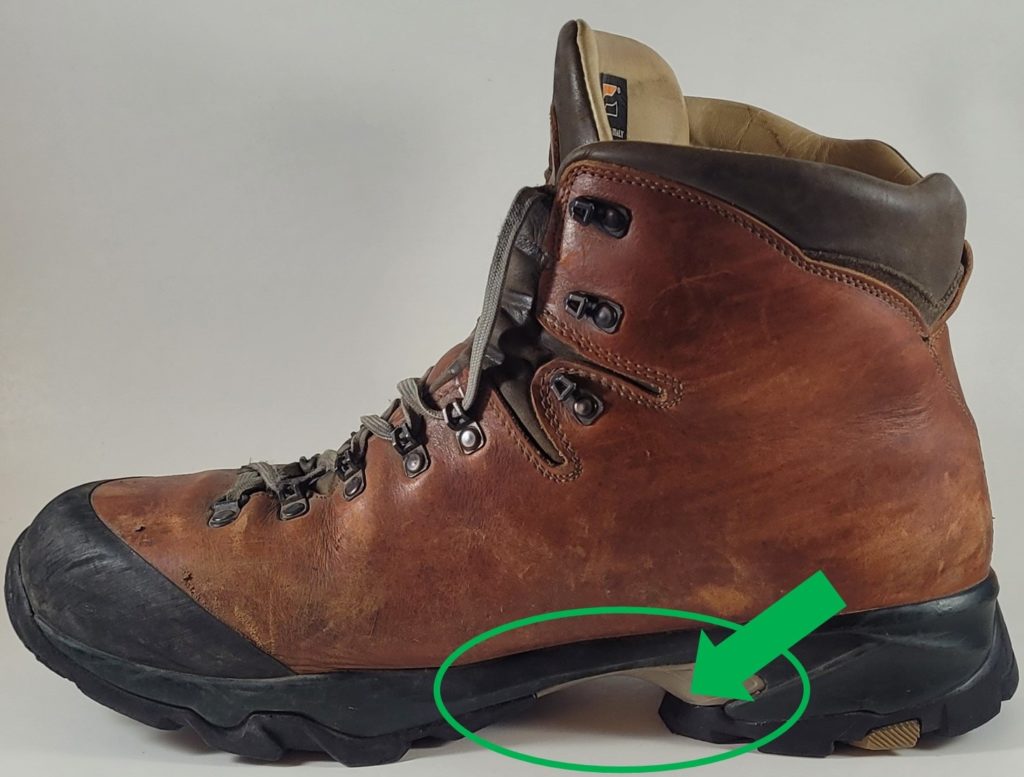
Square back:
I can’t handle the curved heel like you’ll find on Merrell Moab 3’s, although they’re less pronounced than some brands. I once owned a pair of boots like that thinking they’d grip on the downhills like a set of tank tracks and to an extent they did but they were a death sentence on anything slick because half of the heel wasn’t touching when standing vertically. You can see this in the comparison below where the colored arrows represent about where your heel pressure last impacts the ground. The Lowa’s show this the best as they’re almost a square profile but while most boots do have a bit of a slope to the heel it’s generally much less pronounced.
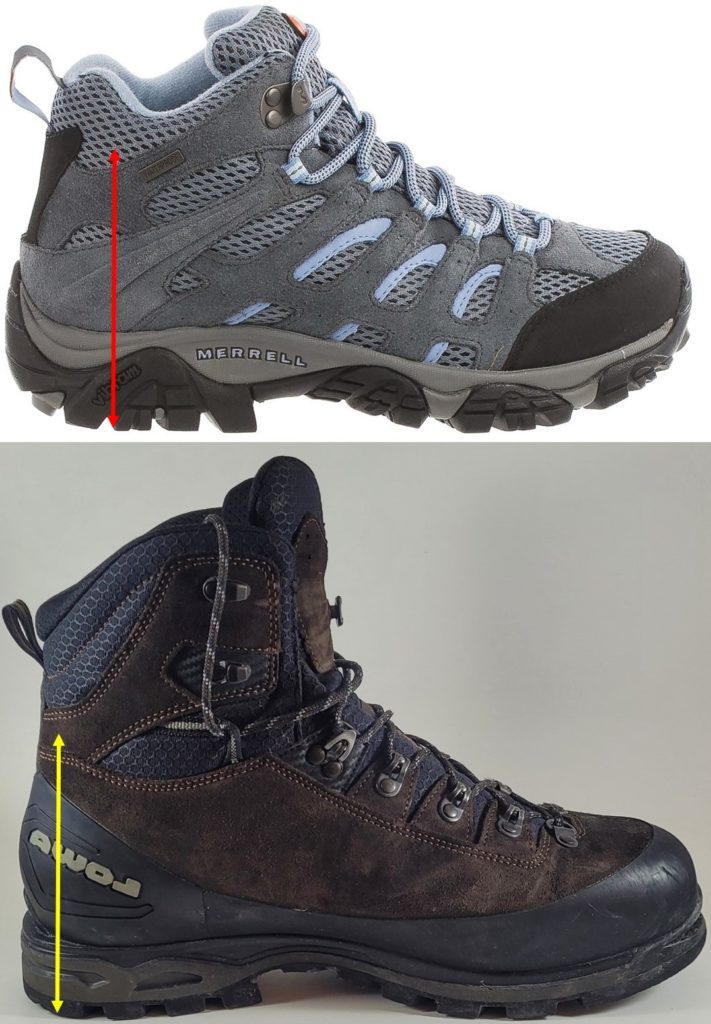
Rubber rand:
Winter and mountaineering boots tend to have a rubber coating around the entire shoe but I’m mostly looking at the toe area. This isn’t a driving concern for regular hikes but when you’re kick-stepping into snow you often hit rocks and ice. Just walking in mixed conditions will see your feet smacking rocks and roots from time to time. There’s a reason even the most basic boots usually put some sort of protection on the toe, be it just a thicker ballistic-nylon or curving the outsole up the toe a bit. Here’s what many years of use looks like on a leather toe without a rand (bear in mind, the leather still had a lot of life left on it):
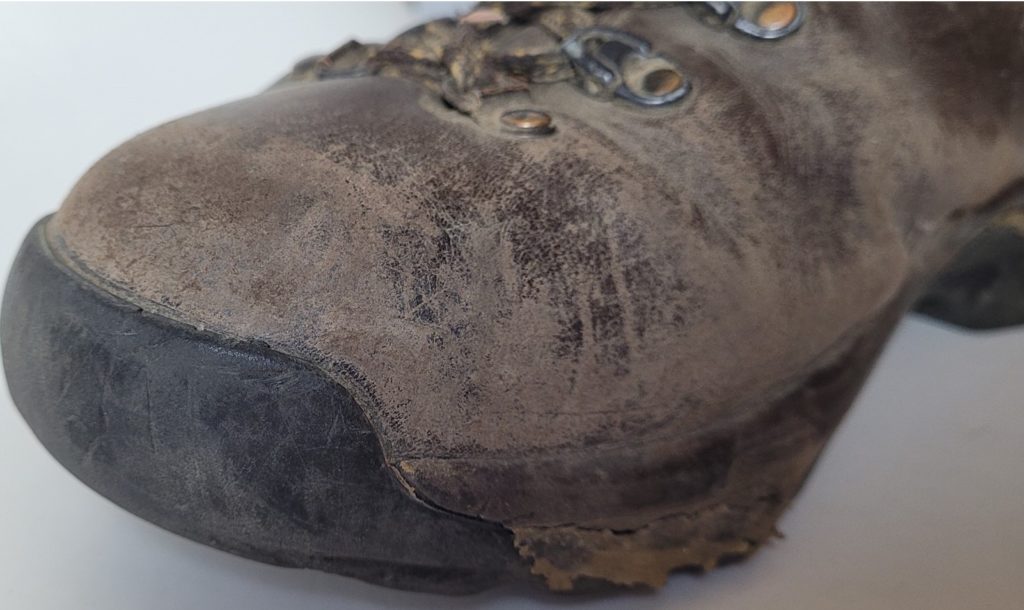
¾ shank or similar:
A shank is literally just a shaft from the heel, through the arch and toward the front of the shoe. They can be a steel beam like in typical work boots, a thick leather beam as in full leather boots (think Whites or Nicks), or some version of a plastic/poly sheet.
The white, ribbed plastic sheath you see here is most likely the shank (or part of a system acting in effect as a shank)
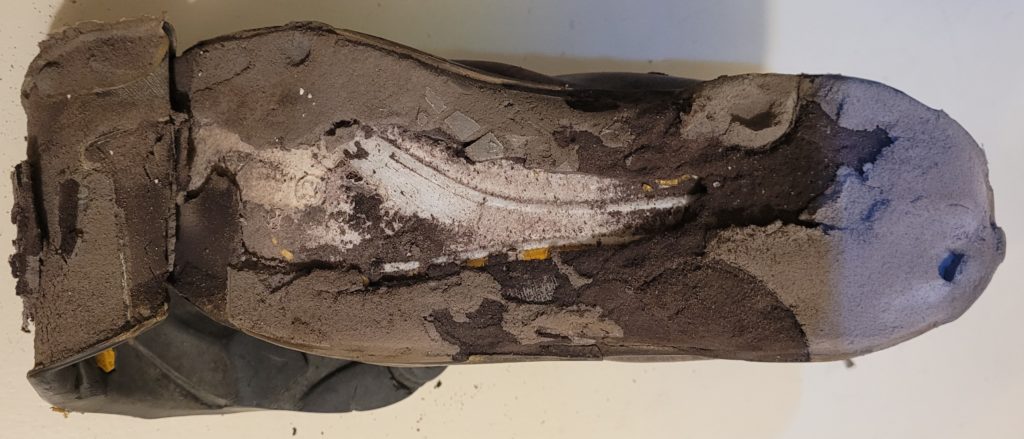
There are likely variations on those themes but they’re not important here. No shank is like your running shoes or flip-flops. They’re incredibly flexible but not supportive in varied terrain. Adding a shank adds torsional rigidity, can support your arch as well as increasing the stiffness of the boot. Try to fold your flip-flops in half and it’s easy. Try to do the same on a mountaineering boot and you’ll give yourself a hernia trying to get them to flex. A half shank is your basic low-top hiking boot which retains a flexible and soft sole. A ¾ shank is literally that – ¾ of the boot. Means your heel through roughly the ball of your foot. Ever stood on a ladder for a long time in tennis shoes? You’ll notice that your feet will flex down a lot and eventually your feet, especially your arches, will begin to hurt. Do the same in boots with a ¾ shank or otherwise very stiff sole and you can stand a lot longer. This added stiffness does wonders for me and means I can step on sharp rocks without feeling them through the sole of my feet. While I do understand the flatfoot, barefoot, zero rise concepts, I prefer the stiff, supportive, and for me pain-free sole. A full shank is generally reserved for extremely steep terrain and mountaineering boots. If you’re spending a week in the mountains of Wyoming hunting for bighorn sheep or hiking up mountains in crampons you’ll likely be wearing full shank boots.
There can be an additional discussion about soles, midsoles and the like which is interesting and important for your feet and wallet, it’s overall not a major consideration for my purposes here. If you’re inclined to do a deeper dive into boot construction then I recommend watching Red Anvil videos. Just don’t be upset that you spent a lot of money on cardboard and foam.
The High-Tech Fancy-Fancy Fallacy:
Many reviews will note something like needing high-tech upgrades or having out-dated design elements. I utterly disagree and dismiss any reviews of this type. Not that high-tech is intrinsically bad or that looks don’t matter (I’ve owned wing tips, cap toes and monk-straps) but rather it doesn’t matter for the purpose of the tool. I say first find utility and looks can follow for any tool upon which your life may rely. For a good example of why outdated and low-tech isn’t necessarily bad, look at Whites Smokejumpers. These are bespoke $700+ all leather boots, first manufactured 170 years ago in 1853, still made to-date and are still considered one of the top shoes for smokejumpers because they can handle the extreme abuse. Modern rubber and thread compounds as needed – but for the utility, not the looks.
A better opinion is like that of Outdoor Gear Lab. For the women’s version of the Asolo TPS they noted as negatives that they were “expensive & heavy” (true) but also that, “If you need the most durable, most protective, most supportive boot that you can find, short of a mountaineering boot, the Asolo TPS 520 GV is what you are looking for.” They also made me laugh because they then wrote, “These are likely to last your whole life. If you can find enough occasions to wear them out, let us know, because you deserve some type of award.” I can appreciate that and I agree with their review, although I do want my reward because I obviously wore mine out…
Closing note:
You don’t need the greatest and best fancy and expensive boots to get to the top of most hikes. I’ve seen Half Dome done in the cheapest of Walmart sneakers, been passed by a hippie in sandals in Colorado, and went pretty far up the Mountaineer’s Route on Mt Whitney in a pair of Nike hiking boots. That said, the right tool for the job sure makes it easier and if you can afford to cry once at $300-400 for a pair of shoes you’ll know they’ll probably last you a decade and if not, 10x longer than any lesser shoe (note that $400 ÷ 10 = $40/year). Wrung whatcha brung, leave the egos at home, and upgrade as you can, as best you can.

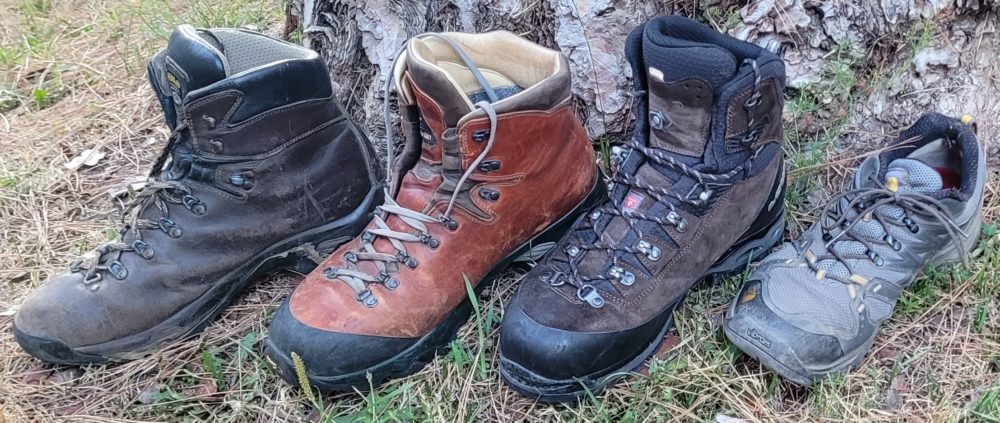




Comments are closed here.